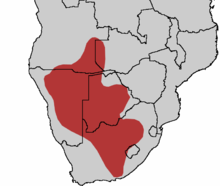|
Eastern clapper lark
The eastern clapper lark (Corypha fasciolata) is a small passerine bird which breeds in southern Africa. It derives its name from the wing clapping which forms part of its display flight. Taxonomy and systematicsThe eastern clapper lark was formerly placed in the genus Mirafra. It is one of several species that were moved to the resurrected genus Corypha based on the results of a large molecular genetic study by the Swedish ornithologist Per Alström and collaborators that was published in 2023.[2][3] This species and the Cape clapper lark were formerly considered conspecific as the "clapper lark" (M. apiata) until split based on genetic analysis.[2][4] The eastern clapper lark and the Cape clapper lark are regarded as forming a superspecies with the flappet lark (Amirafra rufocinnamomea), which is found further to the north.[5] SubspeciesFive subspecies are recognised:[2]
DescriptionThis lark is a 15-cm-long bird, with a brown crown, rich rufous underparts, and a strong bill. It has brown upperparts (greyer in the north of its range). Its call is an ascending "pooooeeeee". Distribution and habitatThe eastern clapper lark is found in much of the drier parts of southern Africa in Zambia, Namibia, Botswana, Lesotho and South Africa. It is a species of open grassland and savannah. Behaviour and ecology The eastern clapper lark is a skulking species, difficult to find when not displaying. It is not gregarious, and individuals tend to be seen in dry habitats feeding on the ground on seeds and insects. The display commences with an ascending flight with wing flapping. It then parachutes down with trailing legs. ReferencesWikimedia Commons has media related to Mirafra fasciolata.
|
||||||||||||||||||||||||||||||||||||||||


